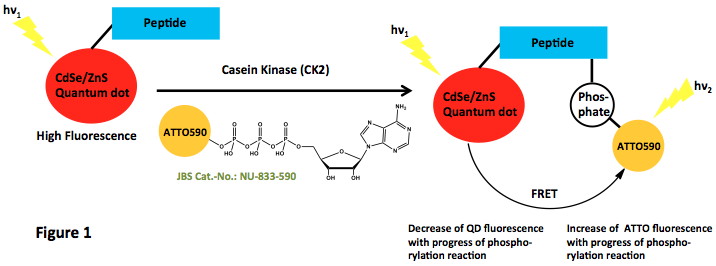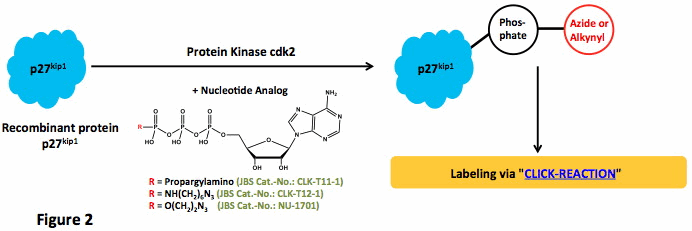In addition to the traditional methods for protein phosphorylation analysis (labeling with radioactive ("hot") ATP[1], phospho-specific antibodies[2] or ATP depletion measurement[3]) we here summarize recent techniques using non-radioactively modified ATP analogs whose modified gamma-phosphate can be transferred by a kinase to its peptide/protein substrate in vitro.
Direct labeling with fluorescently labeled ATP: Freeman et al.[4] implemented quantum dots (QDs) as an optical label for FRET-based analysis of the model system casein kinase (CK2) / alkaline phosphatase (ALP) (Figure 1). ATTO590-labeled ATP served as phosphate donor for the phosphorylation of the CK2 substrate peptide.

Indirect labeling with functionalized ATP analogs: Lee et al.[5] prepared azide and alkyne γ-modified ATP analogs and tested their ability to phosphorylate p27kip1 with wild type protein kinase cdk2. The phosphorylated protein can subsequently be CLICK-labeled, e.g. with fluorescent dyes (Figure 2):

Allen et al.[6] reported kinase-catalyzed thiophosphorylation with ATPγS. The resulting labeled kinase substrates were recognized by new thiophosphate ester-specific antibodies (not shown).
[1] Lehel et al. (1997) A chemiluminescent microtiter plate assay for sensitive detection of protein kinase activity. Anal. Biochem. 244:340.
[2] Till et al. (1994) Use of synthetic peptide libraries and phosphopeptide-selective mass spectrometry to probe protein kinase substrate specificity. J. Biol. Chem. 269:7423.
[3] Kupcho et al. (2003) A homogeneous, nonradioactive high-throughput fluorogenic protein kinase assay. Anal. Biochem. 317:210.
[4] Freeman et al. (2010) Probing protein kinase (CK2) and alkaline phosphatase with CdSe/ZnS quantum dots. Nano Lett. 10:2192.
[5] Lee et al. (2009) Synthesis and reactivity of novel γ-phosphate modified ATP analogues. Bioorg. Med. Chem. Lett. 19:3804.
[6] Allen et al. (2007) A semisynthetic epitope for kinase substrates. Nature Methods 4 (6):511.